HTM 2070 Final Exam Short Answer Flashcards
1/152
Earn XP
Description and Tags
Chapter 1, chapter 2, chapter 5, chapter 7, chapter 8, chapter 9, chapter 10, chapter 11, guest lecture
Name | Mastery | Learn | Test | Matching | Spaced |
|---|
No study sessions yet.
153 Terms
Dowson, Albert & Lomax Event Planning Model
Phase 1: research, concept, development, and screening
Phase 2: detailed planning and design
Content, venue, operations, staffing, marketing, finance
Phase 3: managing the event on site
Phase 4; evaluation and reporting
Event Definition
Planned gathering
Temporary
Memorable
How are events classified?
Event type
Event size and impact
Local events
Major events
Hallmark events
Mega-events
Virtual events
Other
Frequency
Geography
Sector
Internal or external
Cultural Celebration
Festivals, Heritage and
Commemorations
Carnivals, Mardi Gras
Religious Rites
Pilgrimages
Parades
Business and Trade
Meetings
Conventions
Fairs
Exhibitions
Markets
Corporate Events
Educational and Scientific Congresses
Arts and Entertainment
Scheduled Concerts, shows and Theatre
Art Exhibits
Installations and Temporary Art
Award Ceremonies
Political and State
Summits
Royal Spectacles
VIP VisitsMilitary (Tattoos)
Political Congresses
Private Events
Rites of Passage
Parties
Reunions
Weddings
Sport and Recreation
League Play,
Championships
One-off Meets, Tours
Fun Events
Sport Festivals
Mega Event
Largest size and impact
Can generate substantial economic gains, but also high cost
Eg: Olympic Games or the FIFA Football World Cup
Local Event
Local or community based
Unlikely to draw large attendance or media interest
Planned and run by the members of local community or local businesses
Major Event
Attracts visitors from outside the local area
Increased spending in the whole city
Increased media attention for the region
Virtual Event
Online event
Hallmark Event
Identified with a particular town or city and becomes synonymous with that place.
Example Wimbledon
Structure of the events industry
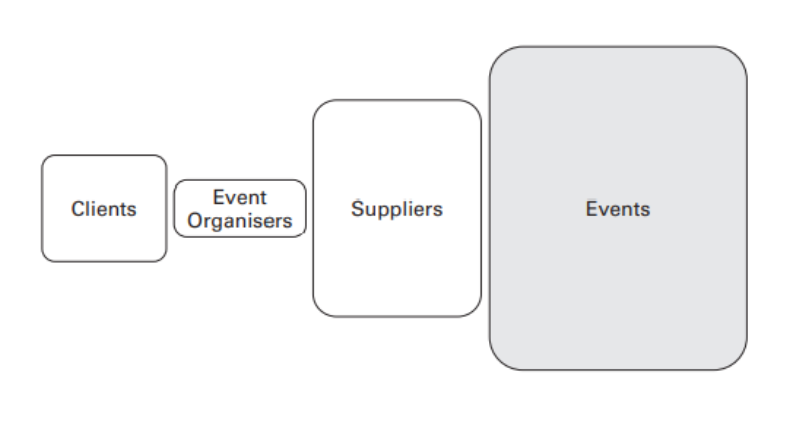
Size of the events industry
Impact of COVID-19.
In 2019 UK 80 million people attended 1.5 million conferences and meetings annually and the sectors 25,000 businesses employed 530 000 people
In 2019 Australia 900,000 international delegates a year well international business event delegates spend was 2.7 billion. 30% of international business event delegates were from Asia and the business event sector created 22,500 jobs.
Relationships with other industry sectors
tourism: large events attract visitors from other towns and countries
Hospitaly: looking after guests at events
Marketing: events as part of strategy
Sports: competition
Notes about the planning process
the planning process is diagram should only be used as a guide. Key tasks are not necessarily sequential.
Overlap between different phases and tasks simultaneously
Amount of time spent will depend
In his opinion, not enough time is spent on the evaluation phase
What are the three essential tasks in phase one?
Stakeholder mapping
preparing the proposal
Screening and feasibility
Stakeholder mapping
different stakeholders → different priorities→ interest to conflict
how would each stakeholder like to see the largest portion of the budget spent?
Preparing the proposal
proposal writing → important → secure most paid jobs.
client will have invited proposals from several event organizers→ choose based on their assessment of the proposal
Screening and feasibility
Two Essential Questions:
Is the proposed event the best solution?
Is the proposed event likely to succeed?
What does Phase 2: the detailed planning stage involve?
Planning the programme
Selecting the location / venuePlanning the site layout
Event production and operational planning
Recruiting the event team
Event marketing
Financial planning
Sourcing suppliers and contractors
Phase 3: Managing the event on-site
movement of people, equipment, goods and services are delivered safely on time and to the right location
all aspects of the site ready for delivery in the load-in phase → detail-driven and time-consuming aspects of event delivery
Crowd management, safety and security, medical and welfare services, hygiene and cleanliness, and risk assessments. For outdoor sites, monitor weather conditions.
Event load-out.
Phase 4: Post-event: evaluation and reporting
feedback from event stakeholders including participants, client, suppliers
Debrief meetings within the team, with key suppliers and partner
organizations
Follow-up on feedback and say thank you. Avoid bombarding people with emails
When is the success or failure of an event largely determined?
how well it is planned
Does the planning process include repetition?
Planning any event involves a certain amount of repetition because there are
various key activities and tasks that are carried out for most events
What needs to be done prior to the commencement of detailed event planning?
clarify the event concept, objectives (including stakeholder objectives) and budget as well as considering the feasibility
What is the importance of delegation?
The design and detailed planning of an event involves a whole host of different activities, and for larger events it is likely an event organizer will need to delegate certain tasks
When should post an activities be planned?
Post-event activities such as the event evaluation need to be planned well in advance in order to provide useful lessons for future events
Can you develop your own event planning model?
Developing your own bespoke event planning model can help ensure a standardized, more consistent approach to planning events and will make sure that you don’t overlook anything important
Phase 2: Detailed planning and design
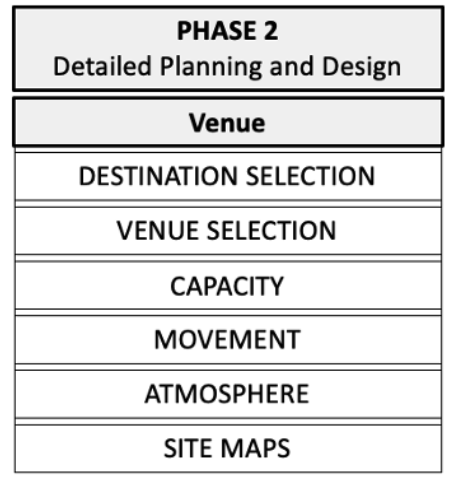
What things need to be considered when selecting a destination?
Safety and security considerations.
Image of the location as it relates to the client, organization and event.
To public transport and road.
Travel Time potential participants
Safety and security considerations:
Nowhere immune from threats to security and safety.
Identify no-go places for event participants.
Identify practicalities of travelling to less-secure destinations.
Include safety and security aspects within risk assessment.
Consider cultural practices and beliefs that might affect participants’ behaviour, and make them aware of cultural sensitivities.
Some destinations are perceived as being more dangerous than others. Do images always reflect reality?
Ask ‘what do attendees need to know?’, from practical arrangements to cautionary advice.
The image of the location as it relates to the client organization and to the event
Exotic locations not always the best
Embarrassment of empty seats
Press reaction
Consider how the location / venue image appears to external and internal stakeholders
Are you creating a welcoming atmosphere, or an unwelcoming one due to perceptions?
Accessibility on public transport and by road
Suitability for the event purpose
Convenience
Access to public transport
Travel time for potential participants
Central locations
Consider multiple events to reduce travel time
What are the steps of venue searching selection?
Issue a venue search brief
Keep a list of venues not available and why
List available venues, costs and limitations
Select venues that meet criteria
Visit venues
Compare results, negotiate, decide
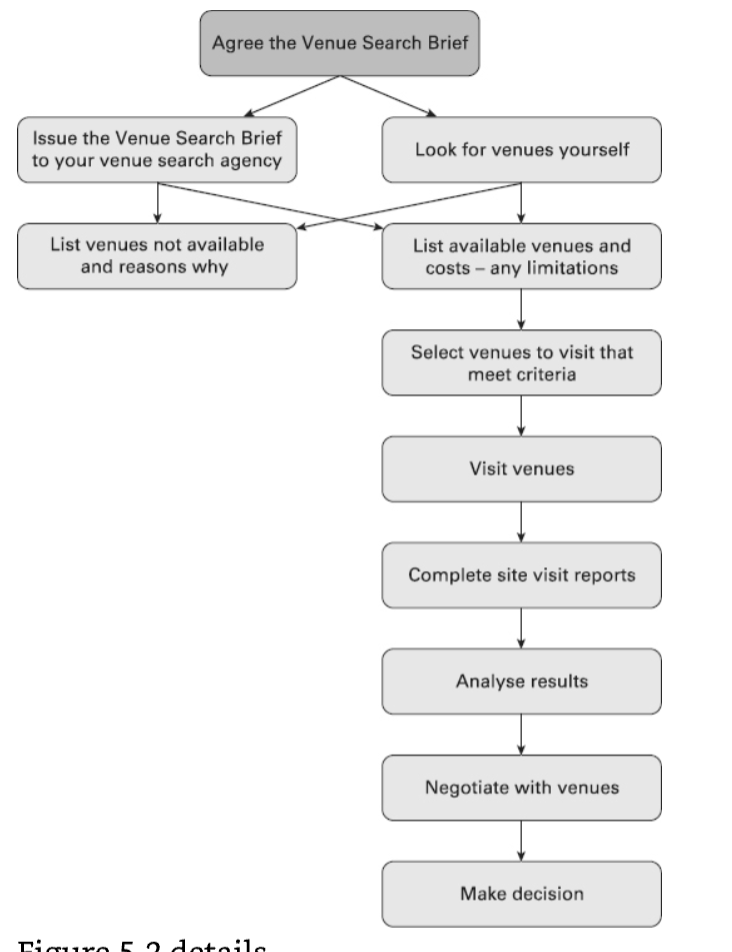
What are the two ways that you can find a venue?
You can either use a venue search agency or find the venue yourself
What is the first step in creating a venue search brief?
Include:
Your organisation’s requirements
Your client’s requirements
The event’s requirements
What must haves should you identify when making a venue search brief?
Geographical location
Transportation links
Image, style, or reputation of the venue or location
Type of venue
Venue atmosphere
Relative size of the venue compared to your event
Room capacities and layout
Suitable facilities available on-site or potential to bring them in,
Cost/value for money
Proximity, quality, and cost of accommodation
What should be included in a venue search brief?
Event details: dates, locations, number of events, number of participants, timings.
Event requirements: room capacities, number of meeting rooms needed,
accommodation requirements.
Catering requirements: breaks, menus, meals, special dietary requirements.
Other considerations: accessibility, car-parking, alcohol, finance and budgets, room layout.
Venue Selection Decision Matrix
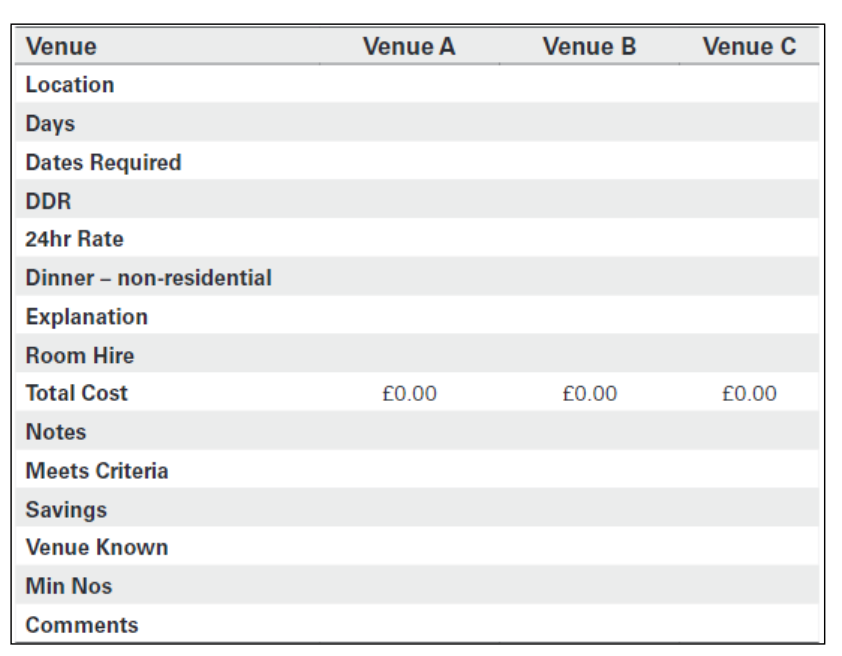
Venue Site Visits
Familiarization or ‘fam’ trips.
General awareness – not specific to an event. Or with a specific event in mind, to compare different venues.
Use a site visit template to gather data.
Event manager hack:
● no substitute for a physical inspection of potential venues
● Identify the constraints and opportunities each venue holds for the event
● Always inspect the toilets
How do you plan a site visit?
Step 1: Get to know your event site.
Step 2: Invite key contractors and suppliers to join the visit.
Step 3: Produce an event pack and circulate to suppliers:
Contact details
Outline of the event
Roles and responsibilities
Useful addresses including the venue, nearest railway station, hotel
Day-by-day production schedule, including the load-in, live event and de-rig times
Site map
Venue Communications
Information for venue includes:
Special requirements especially allergies and dietary restrictions
Numbers attending
Information for participants includes:
Directions to the venue
Information about the venue and its facilities
Working with Venue Operations
Structured approach to changing requirements.
Make sure you control the budget and sign off any changes.
Regular contact with venue sales and operations staff.
Give feedback before, during, and after the event
What must you consider when planning the site layout?
Space
Movement
Atmosphere
Space
Capacity: The number of attendees that an event space can safely
accommodate
Capacity should be determined for the event as a whole.
For complex events capacity should also be calculated for individual
rooms, zones and areas.
Capacity will be influenced by room layout and furniture
Legally capacity is related to the physical space of a venue and ability to
safely evacuate it within a given time
Estimating Capacity
Useful for determining whether a venue would be appropriate for an event
Capacity estimates, based on different room uses, is often available for venue website or on request from the venue
If not available there are some helpful rules of thumb as to capacity of a space.
Theatre Style Capacity (not tested)
Rows of chairs facing front/stage – 2 Square Meters per person
Cabaret/Banquet Style Capacity (not tested)
Guests seated round large round tables (usually 6-10 per table), cabaret style includes a stage or focal point → 4 Square Meters per person
Boardroom Style Capacity (not tested)
Large rectangular or U-shaped table with participants seated round the outside → 8-12 Square Meters per person
Standing events (not tested)
Events where the crowd are standing or moving will experience a variety of crowd densities, manging these is a central part of crowd management
The Purple Guide to Health, Safety and Welfare at Music and
Other Events suggests that across an event site providing a minimum of 0.5 Square
Meters per person
Actual capacity
Make a two scale site map to determine how many chairs and tables the place can accommodate.
Allows you to determine how much space is available for any standing crowds
Crowds need to have a good line of site to any activity or stage
Movement
Considering plan for how attendees will enter, move around, and exit event spaces
What is the acronym used for movement?
ICE:
INGRESS (entry)
CIRCULATION (moving around the venue)
EGRESS (leaving the venue)
Entrances should have adequate space:
For queues to form outside.
For staff to perform appropriate ticket, registration, and security checks.
Immediately inside the venue to allow newly arrived attendees to orientate themselves, before they move into the main event space, or find their seats.
Exits (including emergency exits):
Are an important part of venue safety and evacuation requirements.
Ensuring exits are accessible and kept clear throughout the event duration is a crucial party of safety planning.
Atmosphere
Different parts of the event experience to not interfere with each other and that attendees are able to see and hear what is going on appropriately
All attendees can see and hear what is happening at the event and that the sight design allows for direct lines of sight to a stage or focal point
Video screens and public address systems can be crucial to ensure that all attendees are given the opportunity to experience the event as planned
Designing the Site Layout
Step 1: Obtain a detailed plan of the site
Step 2: Determine the layout of the event
Determine the best position for the central feature of the event.
•Situate complementary activities and attractions next to one another.
Avoid concentrating too many popular activities in one area.
Site medical, welfare and information facilities in a prominent position.
Allocate prime space for VIPs, corporate guests and media partners.
Maintain a visibility distance between front and back of house areas.
Make the event accessible to everyone.
Step 3: Seek feedback on the proposed layout
What should the master site plans include?
A clear key and legend explaining all symbols and colours used on the map
The scale of the map
The orientation of the map (for outdoor maps indicate which way is north)
A grid, with the map divided into boxes
For complex and large events it may be appropriate to use CAD (computer aided design) software to ensure that master site plan remains comprehensible, although smaller or simpler events may only need more basic hand drawn or sketch plans.
How are audiences going to access maps?
Consider digital maps that can be downloaded to smartphones.
Consider large display maps on display around the event site
What is the best way to check if a venue is right for your event?
The best way to check that a venue is right for your event is to undertake a physical inspection yourself – armed with structured checklists so you can ask the right questions.
Should people attending the event in those work the event have different maps?
Trying to fit too much detail on a single site map will only confuse people and it may be a better idea (particularly for larger events taking place across multiple locations) to produce several smaller maps. It is also sensible to produce different site maps for those attending the event and those working at the even
Phase 2: staffing

Complex people concerns affecting events
Need to balance the size of the event, the nature of the event organization and the client organization, the type of event and attendees, within complex team structures.
The pulsating nature of the events workforce requires more people for on-site delivery than are needed to plan an event
Wide range of events roles
Core team
Freelancers → Event planners prefer freelancers since larger corporations charge higher due
to corporate taxes etc.
Onsite support services and outsourced suppliers → the more you outsource, the less
liability on you as an organization
Event production
Health and safety
Technical team
Developing role descriptions
Decide the scope of the events team.
Identify the benefits of events team support.
Capacity to expand to deliver events activity.
Impact on evaluation.
Examples online
Diversity and teams
Include people from a diverse range of backgrounds:
Nationality, ethnicity, gender, sexuality, disability or beliefs.
Differences benefit the team, bringing a range of perspectives and ideas that contribute to the success of the event.
May enable employing organizations to meet specific requirements.
Event participants may also share this diversity
Recruitment and training
Recruiting the right people with the right skills and experience.
Professional and qualified event management staff.
Use formal and informal networks and social media to find jobs and promote opportunities
Staffing levels
Multiple event delivery.
Co-ordinating new and existing events during the delivery period.
Managing different locations and teams.
Consider size and type of event, complexity of programme delivery.
Logistical and security considerations.
Wider team of teams
Event attendees do not care whether your team is made up of core members, freelancers, or suppliers
Pulsating nature of the event workforce
What is risk and liability like?
Build a regular pool of freelancers and suppliers for a consistent, quality event experience
Team-building tools
Understanding personality and communication preferences:
Try tools like MBTI® (Myers Briggs Type Indicator), Belbin team roles.
Identify organizational and individual personality styles.
Work with team building professionals.
Collaborative and partnership working
A new way forward for events in the team of teams.
Beyond hierarchies and control methods.
Competition entails the need for a winner and for losers.
Collaboration and building alliances can enable successful outcomes, for internal and external stakeholders.
Building teams or communities?
Events Manager – role summary
Lead strategic planning, management and delivery of national and local events.
Manage external resource sourcing, selection and procurement processes, e.g., venues, AV, personnel.
Lead coordination of event facilitation, administration and technical support requirements.
Manage event evaluation and initiate improvements’
Manage events team.
Events Co-ordinator – role summary
Coordinate and deliver event management, including venue liaison.
Coordinate speakers and facilitators.
Use online events management tool to deliver high-quality event administration.
Organize exhibitions, communications, e.g. delegate packs, email.
Provide on-site event management, including managing relationships with external suppliers.
Maintain requisition and ordering processes
Events Administrator – role summary
Deliver all aspects of event administration, including delegate bookings, production of delegate packs and delegate resources where required and provide post-event online access to materials
Use online events management tool to deliver high-quality event administration.
Respond to queries; manage team email inbox.
Organize team travel and accommodation.
Phase 2: Marketing
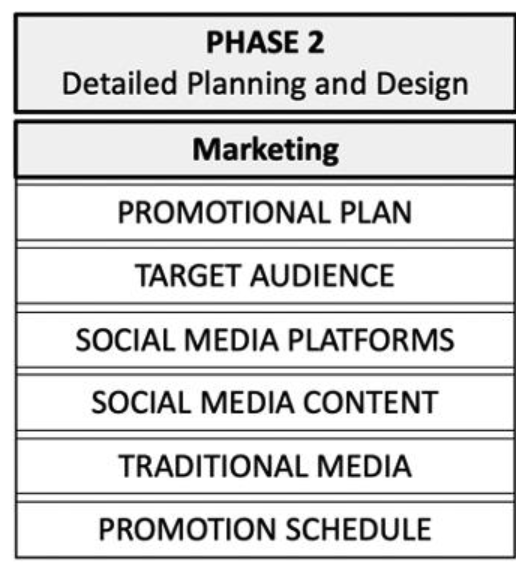
What are the steps of developing a promotional plan
Set the objectives
Establish your budget
Define your target audience and tailor your message
Select the best promotional tools
Measure the results
Step 1: Setting objectives
Possible objectives for event promotions may include the following:
Building awareness
Reinforcing the brand
Providing information
Setting objectives will also enable you to measure the effectiveness of your promotional efforts.
Step 2: Establishing your budget
It’s not easy to come up with a realistic budget for your promotional activity.
Some of the options you can use:
Task method
Percentage of sales method
Competitor-oriented method → analyzing your competitors’ spending on promotional activities and using that information as a benchmark
Incremental budgeting method → starts with your previous budget and makes incremental adjustments
Step 3: Defining your target audience and tailoring your message
Creating an effective promotional campaign requires you to identify and understand the differences between target audiences before responding to them.
Audience segmentation enables you to come up with messaging that resonates with your target audience
Step 4: Selecting the best promotional tools
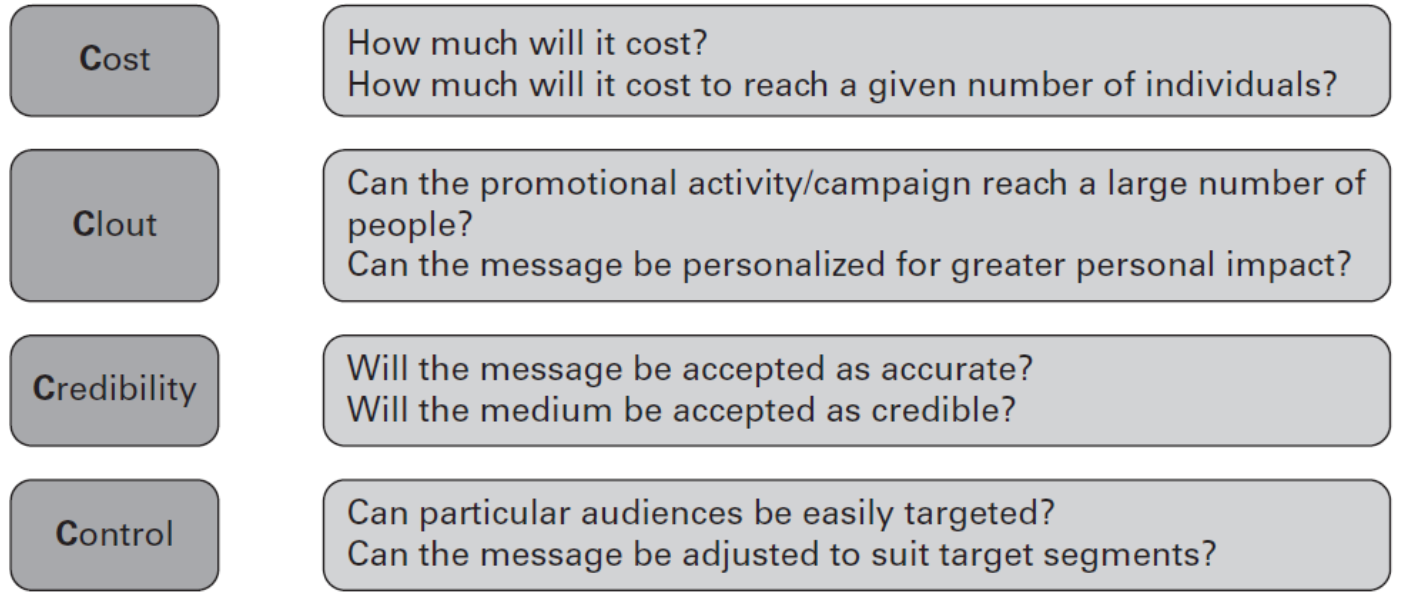
Step 5: Measuring the results
Ticket sales
Return on investment (ROI)
Customer feedback
Competitor response
Two commonly used approaches to segment a target market are:
Two commonly used approaches to segment a target market are:
Demographic variables e.g. Age, Gender, Occupation/profession, Marital status, Family life cycle, Location, Language, Education, Income
Psychographic variables e.g. attitudes, interests and values
Some things to think about to help to ensure that your promotional messages get noticed by your target audience:
Using different message appeals e.g. Fear, Humour, Romance.
Choosing influential message sources i.e. someone credible, trustworthy and likeable.
Speaking your target audience’s language.
Using visuals to engage your audience.
Social media for event promotion
Event promotion and social media go hand-in-hand.
People attend events to connect and interact with one another.
Likewise, people join social media networks to connect and interact with people.
Choosing your social media platforms
Three very important factors to consider, ensuring that you focus your promotional efforts in the right places when it comes to social media:
1. Do your potential attendees spend time there?
2. Does this platform make sense for the content you are producing?
3. How are other event planners using social media?
Ways to promote your event using social media
There is no shortage of options to consider when it comes to using social media:
Creating enthusiasm before the event e.g. event pages, hashtags, customer testimonials.
Maintaining the ‘buzz’ during the event e.g. live posting, real time event updates, behind the scenes footage.
Keeping the conversation going after the event e.g. Posting pictures, get feedback, video montage.
Social media content strategy
Your content strategy focuses on how you can optimize your content for social sharing to increase the reach and visibility of your event on social media.
The two most important questions to ask when devising a content strategy for your event:
What makes a piece of content share worthy in the first place?
How do we make it easy for people to share content?
Social media advertising
Directly advertising on social media can go a long way to growing your audience and engagement. You should consider using social media advertising when:
Your event is new with no established social media community.
There isn’t enough time to create valuable (share worthy) content before the event.
There aren’t enough people to create and share valuable content.
Your promotional budget won’t stretch to other forms of advertising (social media advertising is relatively inexpensive).
Traditional media
Advertising
Sales promotion
Personal selling
Media publicity
Direct marketing
Promotional schedule
Timing is one of the most important factors in a successful promotional campaign.
Creating a promotion calendar is an effective tool to help you plan and stay on top of your promotional activities.
Step 2: finance
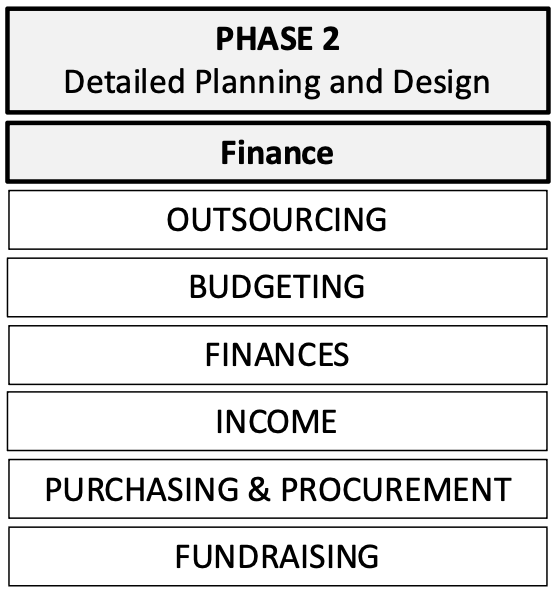
The sources of income for an event can include:
Sponsorship
Ticket sales
Advertising
Resources from within and outside client organization
Donations of time, money or other resources
Why outsource?
Cost – outsourcing can be more cost-effective than outright purchasing.
Time –tight timescales combined with the peak of the pulsating nature of events that requires a bigger workforce on-site, there isn’t always the luxury of time to deliver all the different aspects within the resources of one company.
Expertise and specialist equipment – supplier companies may provide a range of skills, knowledge, experience and/or specialist equipment and facilities that are not needed within the company on a full-time basis, so buying in these resources as needed makes more efficient use of financial resources.
Risks – bringing in expertise spreads the burden of responsibility and reduces the overall risk to the event. Each supplier is responsible for undertaking risk analysis for their specialist area.
Quality – using specialist resources – whether people or equipment – enables the event management team to deliver a higher quality event experience.
In-house may seem cheaper but costs are often hidden.
Issues in outsourcing
Understanding the organizational procurement and finance processes and policies (including deposits and advance payments, where required).
Agreeing processes for confirming variations between the purchase order amount and the final invoice.
Timescales for processing of purchase orders and payment of invoices.
Authority to sign off budgets.
Venue sourcing process
Obtain three or more quotes from different venues that meet the event brief specifications, using a specific venue search company.
Select a venue from the list.
Direct liaison with the venue including signed contracts
Hire or purchase?
Extra equipment needed in case of breakdown
Transporting, storing and maintaining equipment
Technical expertise and support
Quality of resource